I’m going to work through the nuts and bolts of using apps and websites to sell stuff locally. Selling our old stuff has been a key tool in our arsenal to becoming millionaires. This is our step-by-step guide with the tools we’ve used!
I remember when we first started out trying to sell our old stuff locally. I spent far too much time going from website to app to forum post trying to figure out what the best tools to use were. It was both frustrating and confusing.
I’ve waded through that muck so you don’t have to. In this detailed guide, I’ll show you we’ve been selling stuff locally (and online!) for years over many thousands of transactions. Heck, it was the basis for my second major business success: turning a hobby into a business.
Why You Should Sell Your Old Stuff
Before we get into the weeds of all the tools and how to use them, I wanted to give you a little inspiration behind why you should sell your old stuff in the first place.
If you don’t need any such motivation, just jump to the next heading and keep reading!
It always surprises me to hear how often friends and family will simply throw away perfectly good used furniture, electronics, and housewares.
Why opt to destroy something that could be used by someone else?
Why unnecessarily add to the environmental load on our planet?
Jenni and I are certainly far from perfect in this regard—it’s frustrating to see how much waste goes in the garbage (instead of the recycling bin) each week. And sometimes we feel a little lazy and take the car for a trip across town when we could bike. But we should seek to improve!
While I’m often the one that winds up adopting the unloved stuff of friends and family, it’s still striking that people don’t “automatically” know how to take simple steps to sell, donate, or give away their stuff.
It seems natural to me since I’ve been selling my old used thing to pay for my new and improved things since I was about 14 years old. I still have my Heatware account with feedback from the year 2000 (a 24X CD-ROM)!
Even if you really don’t think your old things have any value, why not give it go and see if they’re sellable?
If it’s really worthless why not donate to Goodwill to get the tax deduction or put it up on the freebies section of Craigslist?
Perhaps most presciently, recent studies show that money spent on experiences tend to lead to more happiness than spending money on stuff. You can get into a cycle of selling your old used stuff and replacing it with newer used stuff. You’ll have more money for what is more likely to make you happy: experiences and your own financial freedom.
Follow me down the surprisingly simple path to learning how to get rid of your old “junk” which might just have a diamond in the rough, too.
Here are some of our favorite apps and websites to sell your stuff locally as we attempt to answer the question “how do I sell my stuff locally”, for free!
Apps & Websites to Sell Stuff Locally
There’s a variety of ways to sell your old stuff online and meet locally to make the actual exchange.
There’s the old standbys:
Then there’s the modern apps to sell your stuff:
Of course, this is just the tip of the iceberg though it represents the larger venues. For example, lots of people love Poshmark though it’s focused on a specific category of items: clothing and accessories. It’s also more appropriate for non-local sales where you’ll have to handle packing and shipping.
Platforms and apps that require you to ship to the buyer are for a different article.
Best websites to sell stuff locally
Before the days of eBay, Craigslist, and other websites to sell stuff locally, consumer-to-consumer sales were frequently done via the newspaper classifieds. Listings generally weren’t free.
These days, eBay does still offer local pickup listings and you generally don’t pay fees until a sale is made.
eBay is a good choice if you’re in no rush and want a listing to live somewhere for a while. That’s especially true for higher dollar items (think collectible furniture) that might attract interest outside your region where someone is willing to drive to you for the deal.
Still, there are better choices for all but very niche circumstances than eBay’s local pickup. So, where can you sell your stuff online for free?
1) Craigslist
For most categories, Craigslist remains free. You can create an anonymous account in a couple of minutes. The site still retains the look and feel of the web in its earliest days with a very simple design.

I feel like Craigslist doesn’t have a great reputation, but I’ve never had any trouble. Just be aware that many, many different things and …types of services are sold on Craigslist, so it does have a varied audience.
While I’ve not had issues, Jenni did list some shoes at one point and was asked for some feet pics to go with them.
…
The anonymity of Craigslist has its pros and cons, for sure. Be sure to check out the safety section below, and that applies to any local transaction meetings!
Craigslist’s market share of local consumer-to-consumer sales has been reduced by Facebook’s big push into local sales.
2) Facebook Marketplace
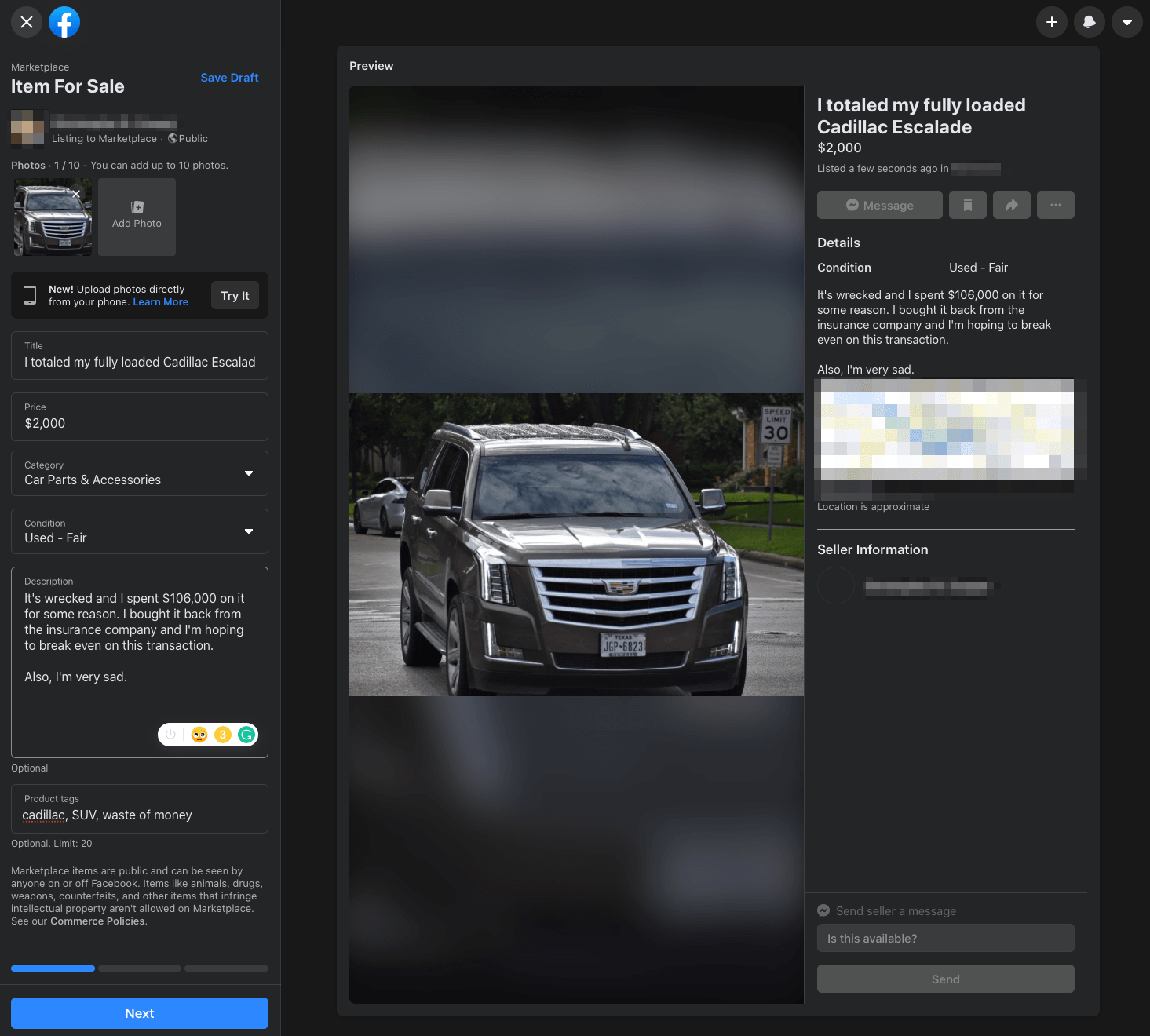
Facebook has a large audience, can use existing profiles to help build trust, and has its own built-in messaging system. They’ve even created a seller review system.
If you’ve already got a Facebook account, I’ve had plenty of success selling our old stuff on the Marketplace platform and would recommend it. Having Facebook’s signup system helps prevent spam “interest” emails. Facebook profiles behind every message help to keep everyone a little more honest, too.
You can even spend a few bucks to “boost” your listing if it makes economic sense to do so.
3) Nextdoor’s For Sale & Free section
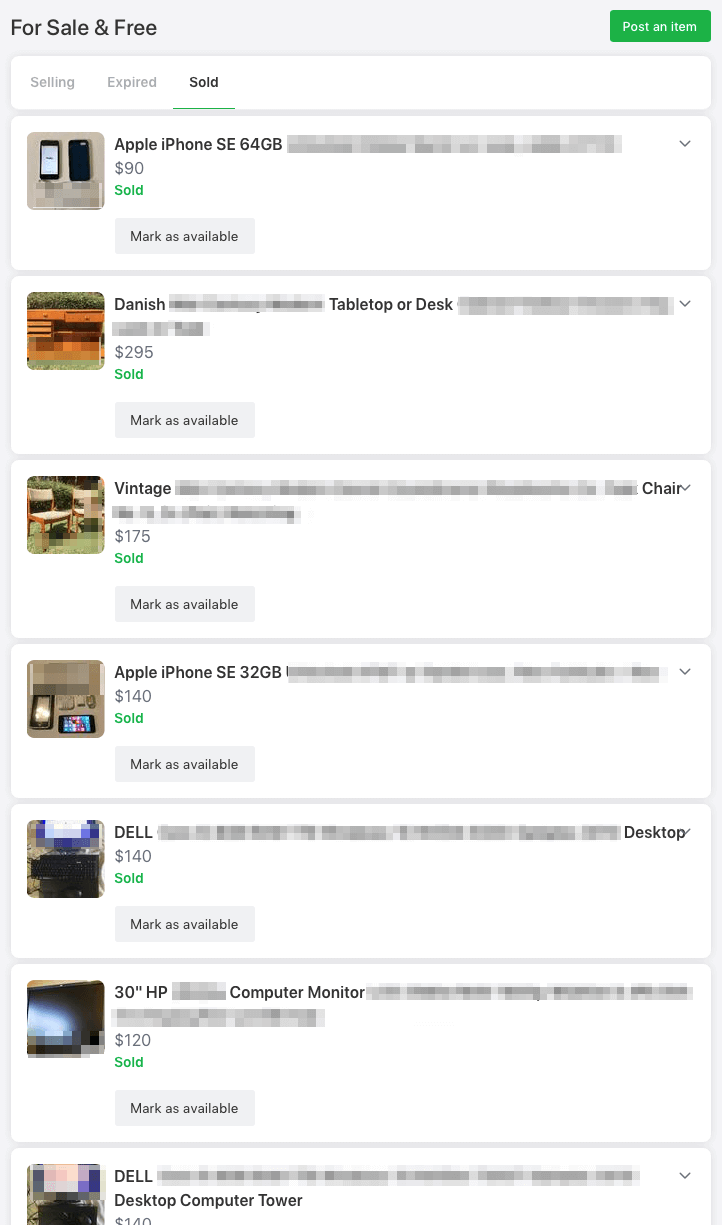
Nextdoor’s website is a much more interesting case. The platform is well-known as a “Facebook for neighborhoods”. It’s something like what used to be your local paper, but run by your neighbors, with a forum of conversation. That lends itself well to a “classifieds” section.
While visuals are important, there’s more of a focus on titling and description. Listings seem to be a little more “sticky”, too.
What websites do we use to sell stuff locally?
I’d estimate that 80%+ of our local sales have come through these two websites to sell stuff locally: Craigslist and Facebook Marketplace.
I like how easy it is to churn on listings on Craigslist, the workflow is simple.
However, the audience size for Facebook Marketplace seems to be only growing. People seem a little less concerned with “getting a deal” and haggling on Facebook Marketplace, too.
Of course, we’ve been doing this for over a decade. The other side of selling things locally is catching up in recent years: apps!
Best apps to sell stuff locally
Ah, the power of modern technology to make you rich.
In the 2000s it was the sudden availability of everyone to sell things online: the explosive growth of the online flea market with eBay. These days, it’s the growth of apps that make unloading the cruft around your house a snap, locally.
1) OfferUp and Letgo sales apps
OfferUp and Letgo are very similar apps that compete in this space. Their aim is to make it as easy as possible for someone with a smartphone to pop open the app, snap a picture as the basis of their listing, input a price and maybe categorize or title the item.
The focus of their listings is in the photo as the app uses a visual list of what’s for sale to help buyers find what they’re looking for.
It’s certainly the easiest, lowest barrier to entry among the choices available to you to make a local sale. That said, I don’t find them to be great choices. Buyers tend to be less interested in the details (since again, it’s focused on visuals). They look to spend a bit less money as the apps have negotiation systems built into them.
I think they’re great choices if you’re in a hurry to make a sale or sell a lot of stuff. A good example where they fit well is if you’re moving house and need to reduce your clutter quickly.
These apps to sell your stuff feel more like a garage sale.
Be wary of attempts to convince you to make your listings available nationwide which will require shipping, potentially fees, and risk with your buyer.
2) Nextdoor’s App
I summarized Nextdoor’s offering in the Best Websites section above, but you should know that they have an excellent and modern app with similar features.
The app serves as an interface to the same set of tools and listings so you can create your initial listing with your desktop to more easily edit photos, add a description, and do your research.
You can use the app to keep up with minor changes, price adjustments, and communications with potential buyers. Nextdoor has its own messaging system that works well with email and the app will let you keep tabs on things very easily.
OfferUp and Letgo listings seem to slide away pretty quickly Nextdoor’s seem to be a little stickier which I think helps with our sales.
3) Facebook App
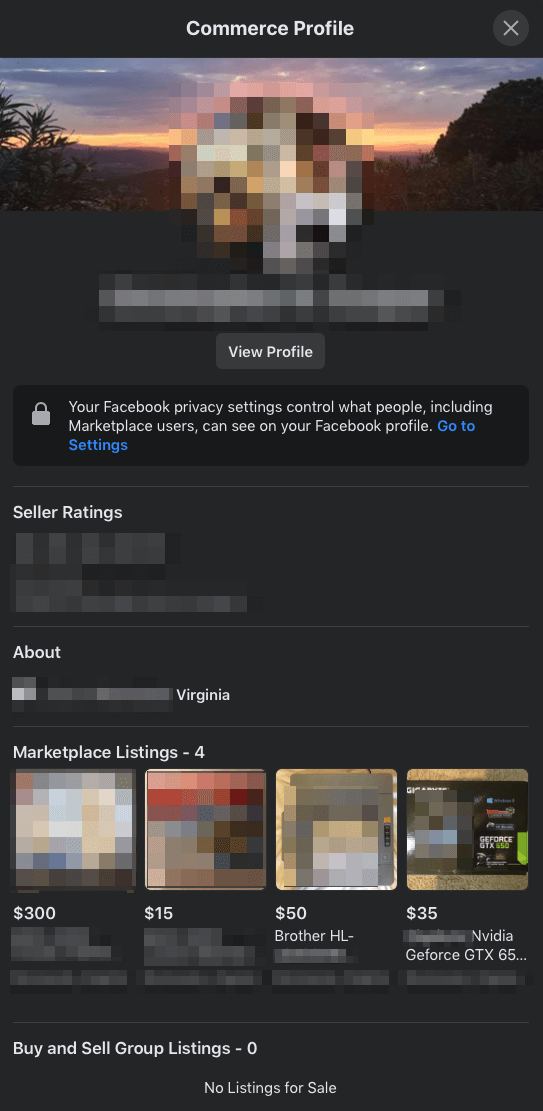
The regular Facebook app has the marketplace system built into it. Like with the Nextdoor app, you’ll have access to all the same listings and similar tools as on the website version.
Facebook’s app tools are a bit more fleshed out than Nextdoor’s and people tend to focus more on photos on Facebook. That means that you can create your entire Facebook Marketplace listing from your smartphone without too much trouble.
Many people prefer that route!
Snapping photos from your phone and easily attaching them to the post lowers the barrier to entry when creating your listing.
Facebook’s Messanger communication system integrates with your marketplace listing. It makes it easy to hold a conversation with a buyer that is very similar to text messaging.
4) Craigslist Apps
Unlike Nextdoor and Facebook, Craigslist doesn’t have a dedicated native app to create and manage your listings.
However, there are several third-party apps that will make the connection for you. You’ll need to trust your Craigslist login information with this third-party, however.
I’ve tried several of the third-party Craigslist apps over the years.
The one I’ve stuck with longest is “CPlus for Craigslist” on iOS. It has all the tools you need to create and manage listings. As a buyer, it even has some great views and listing formats/filtering to help hunt down just the right thing you’re looking for, too.
Perhaps best of all: it’s free.
One downside to Craigslist more generally is that there is no integrated communication platform. Craigslist’s website as well as third-party apps rely on email to communicate with buyers or to divulge your personal contact information in order to communicate. I’d stick to email wherever possible, though.
Best Ways to Price Items for Sale and Make More Money
Once you’ve identified the right apps or websites to sell stuff locally from our listing above, it’s to consider how you’re going to price your items. You need a pricing strategy!
One problem people have when attempting to sell their things locally is that they just don’t know what it’s worth. While it’s fairly easy to look up the price for something brand new and still sold at a big box store, it’s much harder to figure out what something that is a few years old and used is worth.
I’ve got a few simple tips to help you figure that out:
- Check your competitors
- Use eBay’s completed sales listing
- Guess!
1) Check your competitors
Take a look at the platform you intend to sell your item on. Simply search for the same item you have to see what other people are selling that same thing for.
Not only will this give you an idea of what a fair price might be, but you can also cut your competitor’s price by a buck to become the lowest price.
While you’re at it, take a look at their listing to see if they include details you hadn’t thought of. See if you can provide better photos or more relevant information for a potential buyer.
One-up the competition!
2) Use eBay’s completed sales listing

eBay offers a “sold items” filter when you search. This is one of my favorite ways to figure out what the market value is for a thing. You may be thinking:
“But Chris! I’m selling my thing locally!”
No problem, a good rule of thumb for the comparable local price is to take 15% and shipping expenses off the total cost of the sold listing. eBay’s fees are about 10% plus another 3% for PayPal’s transaction fee. You’ll be giving the buyer a better value locally and you’ll earn near what the eBay seller did.
Win-win.
3) Guess!
If you can’t find any examples of your thing locally or on eBay’s sold listings and you really don’t know what it’s worth, that’s okay.
Why not just take your best-educated guess?
Worst case scenario, you’ll waste a little time putting a listing together (they’re free!) and waiting to see if a buyer pops up.
You can still donate, giveaway, or trash it later after all.
Creating the Sale Listing
Once you’ve figured out the value of the things you want to sell and the best venue(s) to sell them on, it’s time to work on the sale listing itself. Whether you’re using an app or websites to sell stuff locally, the workflow is similar. Remember, this is an advertisement: put your best foot forward.
Eye-catching photography for your stuff
You should take a moment to photograph what you’re selling with good lighting, a steady hand, and a full-frame.
Your smartphone is plenty good enough to take quality shots for your listing, the key is in getting lots of angles and good lighting.
- Make sure the item fills most of the frame of the photo
- Include any manufacturer markings
- Highlight damage or indications of anything missing
Try to take your item pictures against a contrasting background which tends to be white. I like to use a large piece of poster board or a white sheet for extra-large items.
If all else fails, your nearest sidewalk on a sunny day makes for a pretty good background choice.
Titles and descriptions in your listings
While you were researching competing listings, you probably found a good listing for your same item. Take a look at how they’ve titled the listing and follow a similar process. My posting titles generally look something like this Madlib:
<Condition> <Item Name> <Model Number> <Variant> <Year> <Completeness>
So, you might wind up with something like this:
Like New Apple iPhone X Black, 256GB 2017 Retail Boxed
Your item description should include an extended version of the title.
- Describe any issues, deliver the exact model information with any extended identifiers.
- Itemize any accessories included, especially things like instructions or the packaging.
- Consider including the manufacturer’s production description if it might be helpful to the buyer when browsing.
Setting the deal parameters
Lastly, you might want to describe how you’d like to meet up and deal in general. A lot of people making local deals will expect a little haggling in my experience. Since I price things at market values I have researched, I put in my descriptions “price is firm”.
In addition, I mention a suggested safe location to meet up which tends to be the nearby grocery store. It has benches, cameras, and bright lighting along with an easy parking lot to access.
I also state the best way to reach me (usually the venue’s messaging system so as to not expose my phone number) and that I will reply to any questions quickly.
Lastly, I like to add that “if you see this posting, it’s still available”. That seems to cut down on the number of messages simply to ask if it’s still available. Just be sure to take your listings down when you’ve made the sale!
Safely Use Apps & Websites to Sell Stuff Locally
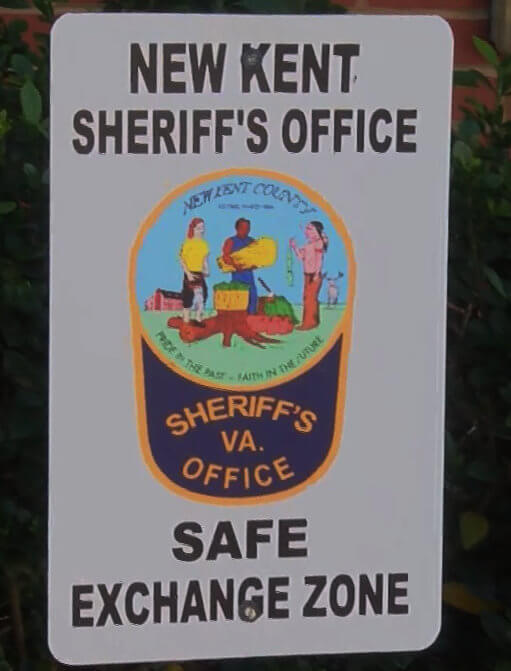
This idea of local person-to-person sales has become so prevalent that police stations and public spaces around the country have been designated “safe transaction zones”. Cameras record vehicle license plate information coming in and out along with other angles providing recordings of the person-to-person transaction itself.
This offers at least some form of security for the two parties involved.
While we tend to use the entry area of a grocery store nearby, we have at least a handful of these designated zones within walking distance of our house. It seems safety is a big stumbling block for people considering selling their things themselves locally, it’s great to see municipalities trying to make the process safer.
Personally, I’ve been selling old electronics, computers, and extra stuff around the house via Craigslist for over a decade. I’ve yet to have had any issue with a local deal and I’ve made many dozens of transactions as the buyer as well. I don’t know precisely how many sales I’ve gone through, but I’d say it safely exceeds one hundred. Now, that’s just my anecdotal experience.
Safety should be taken seriously.
Of course, most of the negotiation has already been done long before the meeting takes place. It’s common to talk about the condition of what’s being sold, ask detailed questions, and even negotiate price right within the messaging system of the app you’re using. In this way, the meeting is more just a formal physical transaction—the exchange of cash and the item sold.
Making the Sale
Once you’ve got quality photos, a descriptive title, and a description that’ll help make the sale, make your posting live and …wait for a buyer!
When they reach out, reply promptly and be personable. Person-to-person financial transactions are awkward, it’s not something we do every day. You can really improve the experience for your buyer and make an easier sale by just being friendly and approachable.
Being more comfortable and open about money with strangers can help you communicate better with friends and family about money. It’s a good practice.
Set a date, time, and location to meet. Try to agree on the price beforehand. One way I bring this topic up is to simply ask the buyer if they’ll need change. I only accept cash.
I like to tell the buyer to message me about 30 minutes in advance of our scheduled time to confirm they’re still on schedule.
Make sure you have a way to communicate with the buyer in case there are any last-second snafus. Most of the apps have good built-in messaging systems but there’s always text messages if you’re comfortable exchanging your number.
Make Money From Selling Your Old Stuff
Once you’ve got a few listings under your belt, you’ll be used to the workflow for creating postings on your platforms of choice—whether that’s apps or websites to sell your stuff locally.
You can build it into a routine, a habit, as you acquire upgrades or improvements. We’ve incorporated this into our routines as you can see in our last monthly balance sheet as a bit of local sale side income showed up. We’ve tried to build a habit of using apps and websites to sell stuff locally into our consumer consumption cycle.
Building a mentality that “everything is for sale” has let us upgrade our old stuff over time and build our wealth, a key component to becoming millionaires in 10 years.
We should strive to be happy with what we have, there’s diminishing returns once you’ve reached enough money, after all. Sometimes our Stoicism will run weak and we’ll incorporate new things in our lives. You should do your best to maximize the value of your old stuff when this happens.
Try to avoid further environmental and financial costs to the society around you by giving your old stuff a new home that isn’t the landfill.
Building the habit of selling your old stuff will add a little more wealth to your bottom line, getting you that much closer to—or help maintain—financial independence.
How to Sell Your Stuff FAQ
We routinely get questions from friends and family asking how to sell their stuff online. This post addresses that question from the context of trying to sell your old stuff locally with the apps and websites that’ll help you do so. Here are several frequently asked questions and our answers addressing how to sell your stuff.
We mentioned Facebook Marketplace, Craigslist, and Nextdoor as great apps & websites to sell your stuff online for free in this post. None charge fees for most listings as long as you are willing to handle the monetary transaction yourself. Using their platform as an escrow service, or putting a third-party like PayPal or Venmo in the middle might mean fees apply especially as it pertains to credit card payments. These are great resources to sell your stuff online for free when you can make the transaction locally.
If you’re happy to ship your stuff, eBay’s modern fee structure is generally free upfront. For up to 200 items per month, there’s no cost to list items on eBay’s marketplace for the vast majority of item categories. Fees are subtracted from the final value of the item when it’s solid (generally about 10%). You’ll also need to pay to ship the item and transaction fees where appropriate (for example, PayPal’s 3% payment fee).
We’ve been selling stuff locally since about 2006 over the course of many thousand transactions. In our experience, Craigslist and Facebook Marketplace are the most productive websites to put your effort into in order to sell stuff locally. Depending on your city, Nextdoor can be a great marketplace as well.
Letgo and OfferUp are solid venues too, though they tend to feel a bit more like a garage sale with more negotiation and clutter.
If you handle the payment yourself, none of these five marketplaces charge fees to list or sell items locally.
If you’re like us and frequently upgrade your smartphone, you may find them collecting dust in a drawer. Don’t let that happen! We really like Swappa as a used smartphone marketplace.
By keeping an eye out for new smartphone releases, you can often purchase a great lightly used phone (1-2 years old) for 50% less than it cost when new. If you sell your previous phone in this same release window, you can usually recapture most of the cost you paid for it since depreciation has already taken its toll.
We usually pay about $200 to upgrade our phones every two years and sell the old one for $100-150.
While it’s beyond the breadth of this guide to offer a “how to sell a smartphone” rundown, be sure to erase all your personal data from the device before selling it! In addition, many manufacturers offer an activation lock to help prevent theft which you’ll want to disable for the next owner’s sake.
Swappa is an excellent marketplace that will walk you through selling your old smartphone as well as help you find a good price on a replacement one. We’ve also had success selling our smartphones locally via Craigslist and Facebook Marketplace.
Aside from the typical local selling websites and apps (Facebook Marketplace, Craigslist, and Nextdoor), Poshmark is the number one website we recommend to sell your clothes online.
Their fee structure is easy to understand, based on the selling price of the items. There’s no cost to list items. They provide an easy shipping workflow to help you print labels, too.
Poshmark is mainly geared toward mainstream fashion.
We’ve also had some success selling used clothing on eBay, especially in related lots (like a set of dress shirts all the same size).
Lastly, be sure to consider the value of just donating quality used clothes to a local non-profit. National organizations like Goodwill or the Salvation Army likely have a location near you. The tax deduction could be valuable depending on your tax situation, too!
If you’ve got a question that we should add our to our Apps & Websites to Sell Stuff Locally FAQ, let us know in the comments!
What novel ways have you found to make money from your old stuff? Let us know in the comments!

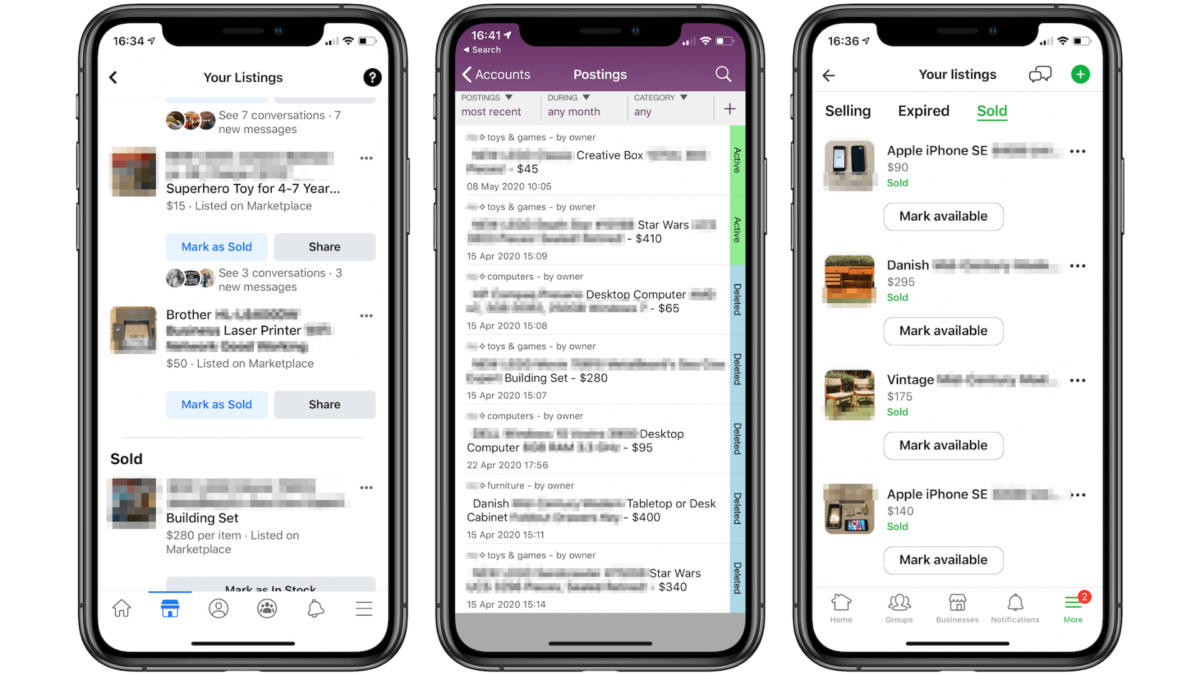
2 replies on “7 Apps & Websites to Sell Stuff Locally (Detailed Guide How)”
This is such a helpful post! I have been in the position before of trying to sell things but I never know how much to price them at or the bets platforms to sell them on. Thank you for sharing!
Amber
Thanks for the kind words, Amber! Hopefully it’s helpful–especially figuring out pricing. I know that’s tricky.